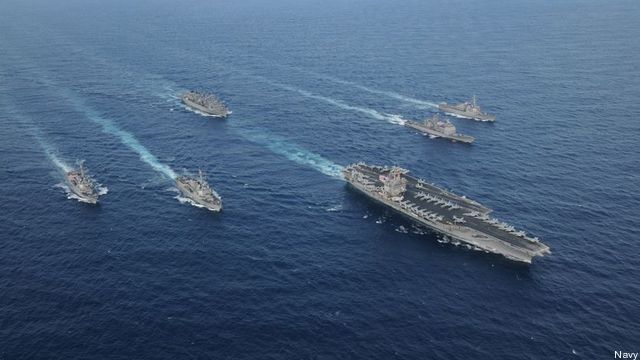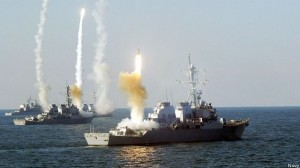Aircraft Carrier: The Nation’s Trump Card Reborn
Posted on

USS Enterprise carrier group
The usefulness of the aircraft carrier, long the centerpiece of American naval power in the world, was in serious question, even by me, one year ago. Chronic underfunding, poor strategic assumptions and bad acquisition decisions had left the carrier defensively unprotected and offensively underpowered as its airwing both shrank in size and striking range.
President Trump’s election and his public commitment to a 350-ship Navy as well as his explicit call for a twelfth carrier, effectively truncates these concerns, bringing the promise of additional capabilities that will ensure the safety and effectiveness of the carrier.

Jerry Hendrix
Anti-Access/Area Denial (A2AD) weapons highlight the need to increase the range of the carrier’s aircraft to keep the flattops relevant. In an era marked by flat defense budgets and a dwindling carrier fleet, down from 15 in 1991 to 10 today, the carrier simply didn’t have enough defense around it, with escort ships falling from eight (two cruisers, two destroyers, two frigates and two fast attack submarines) to six and even two (a cruiser and destroyer) in some cases. Also, the carrier’s offensive power, in the form of its embarked airwing, has shrunk from a Cold War compliment of 85 aircraft with an average combat range of 908 miles to a modern compliment of 62 aircraft with a range of 496 miles. These characteristics threaten to deny the carrier an effective role in a high-end fight against a rising power like China or established regional powers like Russia or Iran. Had these conditions of fiscal restraint and quantitative decline persisted, then it would have eventually been necessary to move on to another approach to maritime power more in keeping with nation’s trend towards a passive strategic vision as promoted by the Obama administration. However, the election of Donald Trump signaled a domestic rejection of these “lead from behind” policies and conveyed the need to reassess the viability of the carrier.
Donald Trump campaigned explicitly on the promise to grow the size of the United States Navy to 350 ships from its low of 271 ships in the fall of 2015 as part of his plan to broadly rebuild the nation’s military after years of strenuous operations and capacity decline. The last time the US Navy held 350 ships in its inventory was during the late 1990s, a decade that saw the maritime force shrink from 530 to 318 ships. It was an era of uni-polarity, expanding alliances, peace keeping, nation building and permissive maritime environments. Carriers launching airstrikes into the former Yugoslavia could nestle close to shore in the Adriatic, secure in the knowledge that no one was coming out to attack them. Older nuclear powered escort cruisers, which could keep up with the high-speed carriers without being concerned with running out of fuel, were retired, and then older variants of the anti-air defensive Ticonderoga class cruisers were decommissioned as well. An entire class of 31 anti-submarine Spruance class destroyers were mothballed well ahead of schedule then sunk as targets during training exercises. More recently all 51 of the nation’s convoy escort frigates left the fleet without replacement. While the Navy retained 22 cruisers and continued to build robust Arleigh Burke class destroyers, it was clear that the service was, in the parlance of the Pentagon, “accepting risks” in the deployment of its fleet in the face of rising threats.
Those threats came primarily from China, Russia and Iran, who, while the United States was focused on combat operations in Afghanistan and Iraq, began to develop and deploy a battery of sensors and weapons intended to push American carriers farther out to sea, beyond the attack range of their embarked airwings. By the time the United States began to break its tight strategic focus on counter-terrorism land wars, the fleet had fallen well below 300 ships and was no longer able to provide sufficient defense to the carrier in contested waters. Operations such as a relief mission in support of Taiwan or a rapid movement of troops and equipment into the Baltic sea were no longer a given. The common presidential question of “where are the carriers” began to progress towards a question of concern for their safety rather than an appeal for their mobile and robust strength.

Aegis
But a 350-ship Navy, an increase of 76 ships from the present inventory, will bring the additional air-defensive Aegis destroyers as well as new escort Small Surface Combatants to surround and protect the carrier in hostile environments. The carrier’s airwing will also see and expansion in its range and capabilities, as President Trump expressed interest in buying more FA-18s even as his Defense Secretary James Mattis acknowledged the continued importance of the stealthy F-35 in contested A2AD airspace.
The bottom line is that President Trump’s commitment to a larger Navy reflects the investment that is both necessary and prudent to keep the carrier relevant and the nation militarily strong. The debate about the viability of the aircraft carrier was important in that it helped to identify the actions needed to ensure that the centerpiece of the American fleet could remain in the fight in future security environments, but that debate ended on Election Day and the elevation of a president committed to a growing Navy.
Subscribe to our newsletter
Promotions, new products and sales. Directly to your inbox.
